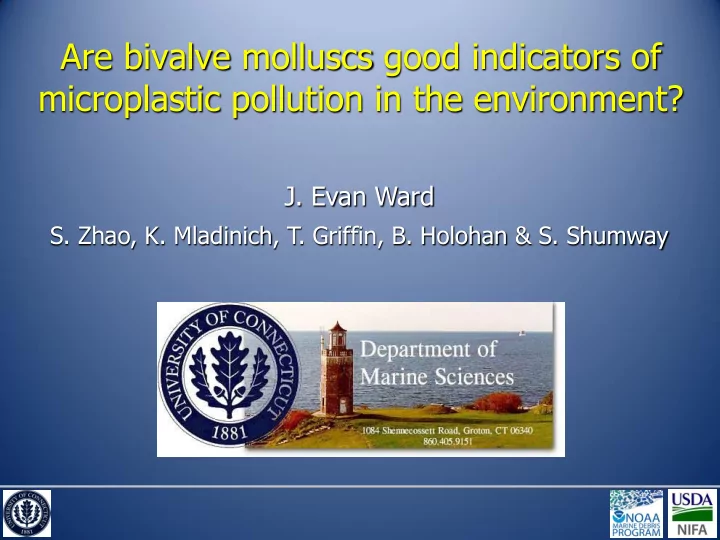

Are bivalve molluscs good indicators of microplastic pollution in the environment? J. Evan Ward S. Zhao, K. Mladinich, T. Griffin, B. Holohan & S. Shumway
Background – environmental concentration? [Microplastic] varies considerably Location (population size) • Stochastic ocean processes • Little standardization of sampling methods Difficult and time consuming • Episodic • What about biomonitoring microplastics? Continuous sampling • Easy to collect and process • Similar to biomonitoring of other anthropogenic materials POP, Oils, Heavy Metals • Photos: Monmouth College, F. Norén
Background – microplastic bioindicator? Attributes of a good bioindicator Sedentary (or resident) • Interact significantly with the surrounding environment • Ubiquitous and relatively easy to collect • Uptake, without bias, the pollutant in question • Environment (microspheres & microfibers) ≈
Background – microplastic bioindicator? What about bivalve molluscs? Sedentary • Interact significantly with the environment (3-5 L/hr/g mass) • Ubiquitous and relatively easy to collect • Used as indicators of dissolved pollutants (mussel watch) • But…..do they uptake , without bias, microplastics …???? • Environment (microspheres & microfibers)
Objective Experimentally determine if bivalves indiscriminately ingest and egest microplastics of different size and shape Implications for bivalves as bioindicators Implications for transfer of microplastics to higher trophic levels jonrowley.com
Methods – general Oysters and mussels exposed to polystyrene microspheres & nylon microfibers Sphere diameters = 20, 113, 287, 510, 1000 µm 100 µm • Fiber lengths = 75, 587, 1075 x 30 µm • Two different experimental approaches 50 µm First – video endoscopy experiments (qualitative) • Second – feeding assays (quantitative) • Microplastics delivered near inhalant aperture Five to six doses per animal (1 every 20 min) • Concentrations below excess pseudofeces production • (< 735 spheres; < 495 fibers)
Methods – endoscopy exp. Bivalves held in 1-L chambers Supplied with air • Fed low concentration of microalgae (<5,000 c/ml) • Optical insertion probe positioned Within the mantle cavity (gill and labial palps) • Near the pseudofeces-discharge site • Microplastics delivered Video digitally recorded and analyzed
Methods – feeding assays Bivalves held in individual 750 ml chambers Supplied with air • Fed low concentration of microalgae (<5,000 c/ml) • Microplastics delivered • Held in original chambers for 3 hrs Then transferred to clean chambers • Held for additional 45 hrs (with food) • Pseudofeces (rejecta) & feces collected Stereomicroscope used for collections - critical • Biodeposits digested (NaOH) Plastic particles quantified using microscopy •
Results – endoscopy All video is real time 1) Both species capture & Capture & transport of plastics transport all microplastics Mussel (flat gill) • 2) Oysters select plastics on gill Oyster (plicate gill) • Rejection of plastics Mussel Oyster 1) Rejection occurs within minutes of exposure 2) Pseudofeces too small to be seen by unaided eye
Results – feeding assays (biodeposits) Scale bars = 200 µm
Results – feeding assays Rejection of microplastics in pseudofeces p < 0.05 p < 0.01 Data are means +/- SE (n = 7-11 oysters and 8-10 mussels); Tukey HSD test
Results – feeding assays Egestion of microplastics in feces in < 3 hr Material egested in feces in < 3h does not undergo full digestive process Data are means +/- SE (n = 7-11 oysters and 8-10 mussels); Tukey HSD test
Other evidence – lab studies Ingestion / rejection depends on Similar results found for plastic coating & glass Oyster Mussel 10 µm Left: Tamburri & Zimmer-Faust 1996; Right: Ward & Targett 1989
Other evidence – field studies Microplastic in the environment Water & aggregates (in 76%: 1.3 particles/L) • Mussels (0-2 particles/animal) • Zhao et al. 2018 (ES&T) • Theoretical uptake of microplastics in situ Considering mussel size, temperature & pumping rate • Mussels could clear/ingest 25-45 particles/day • Raman & FTIR analyses
Perspective Movement of plastic particles into and out of mussels is rapid Environment (microspheres & microfibers) ≈ Rejection Egestion (pseudofeces; min) (feces; < 3 h)
Conclusions Bivalves capture and process a wide range of microplastics But only a fraction of the particles are ingested • Pseudofeces is produced even at low particle concentrations Much cannot be seen with the unaided eye • Ingestion and egestion depends on particle size and shape Low-aspect ratio particles – small ones ingested & retained longer • High-aspect ratio particles – no differences with length • still 25% to 55% rejected & > 50% rapidly egested Bivalves are not good bioindicators of environmental microplastics Complexity of bivalve feeding needs to be considered •
Future questions Which types of plastic particles are more likely ingested? Ongoing: particle shape, polymer type, surface characteristics • Ongoing: developing model to predict ingestion • Which suspension feeders would be good bioindicators of MP? Ongoing: investigation into particle selection capabilities • What is the environmental fate of MP-laden biodeposits? Implication for deposit feeders •
Acknowledgements Assistants Jenn Wozniac (Undergraduate) • Vena Haynes (Graduate Student) • Funding agency NOAA, Marine Debris Program • USDA, National Institute of Food and Agriculture Program •
Background – environmental concentration Varies considerably Location (population) • Stochastic ocean processes • Little standardization of methods Sampling • Extraction & isolation • Identification • Verified concentrations ca. < 1 to 5 particles / L • Zhao et al. 2018 (ES&T) •
Recommend
More recommend